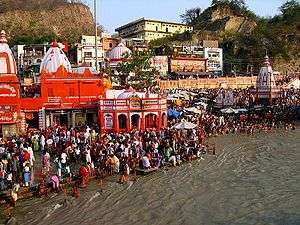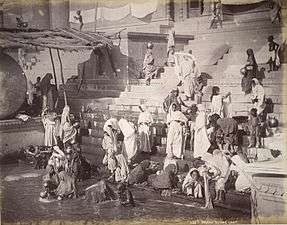Ghat

As used in many parts of South Asia, the term ghat refers to a series of steps leading down to a body of water, particularly a holy river. In Bengali-speaking regions, this set of stairs can lead down to something as small as a pond or as large as a major river.
Etymology
The word ghat is explained by numerous Dravidian etymons such as Telugu katta and gattu (dam, embankment) Tamil kattu (side of a mountain, dam, ridge, causeway) and Kannada gatta (mountain range).[1]
Along the rivers Ganges and Narmada
The numerous significant ghats along the Ganges are known generally as the 'Varanasi ghats' and the 'ghats of the Ganges'. In Madhya Pradesh in western India there are further significant ghats along the Narmada River. People who live on the steps are also called ghats.
The word is also used in some places outside of the Indian subcontinent where there are Indian communities. For example, in George Town, Penang in Malaysia, the label "Ghaut" is used to identify the extensions of those streets which formerly ended in ghats before reclamation of the quayside (e.g., Church St Ghaut - in Malay Gat Lebuh Gereja - is the name of the extension of Church St beyond where the street used to descend to the water via a ghat). In both Penang and Singapore, there are areas named Dhoby Ghaut (dhobi meaning "launderer" or "laundry", depending on whether it refers to a person or a business).
Shmashana ghats
Ghats such as these are useful for both mundane purposes (such as cleaning) and religious rites (i.e. ritual bathing or ablutions); there are also specific "shmashana" or "cremation" ghats where bodies are cremated waterside, allowing ashes to be washed away by rivers; notable ones are Nigambodh Ghat and Raj Ghat in Delhi on the Yamuna, that latter of which was the cremation area for Mohandas Karamchand Gandhi and numerous political leaders after him, and the Manikarnika Ghat at Varanasi on the Ganges.[2]
Other uses
In Marathi, Hindi, Gujarati and Kannada, ghat is a term used to identify a difficult passage over a mountain.[3] One such passage is the Bhor Ghat that connects the towns Khopoli and Khandala, on NH 4 about 80 kilometres (50 mi) north of Mumbai. Charmadi Ghat of Karnataka is also notable.
In many cases, the term is used to refer to a mountain range itself, as in the Western Ghats and Eastern Ghats. 'Ghattam' in Malayalam also refers to mountain ranges when used with the name of the ranges being addressed (e.g., paschima ghattam for Western Ghats), while the passage road would be called as a 'churam'.
Gallery


 Ganga Dashahara in 2005 bathers to the riverfront in Haridwar.
Ganga Dashahara in 2005 bathers to the riverfront in Haridwar. Women and children at a bathing ghat on the Ganges in Banares (Varanasi), 1885.
Women and children at a bathing ghat on the Ganges in Banares (Varanasi), 1885. At Dakshineswar Kali Temple, Dakshineswar, West Bengal.
At Dakshineswar Kali Temple, Dakshineswar, West Bengal. A view of the Ghat of Varanasi from the River Ganges.
A view of the Ghat of Varanasi from the River Ganges.
See also
References
- ↑ Jaini, Padmanabh S. (2003). Jainism and Early Buddhism. Jain Publishing Company. pp. 523–538.
- ↑ "Funeral pyre to be set up in Lahore". Daily Times Pakistan. Archived from the original on 2007-02-13.
- ↑ Navneet Marathi English Dictionary. Mumbai 400028: Navneet Publications (India) Limited. Archived from the original on 2009-01-24.
External links
| Wikimedia Commons has media related to Ghats. |
- Ghats of Varanasi, webpage at Varanasi official website.